Vera Olkhovskaya
Processing the cut of the waist of a skirt or trousers with a facing
The method is equally suitable for skirts and trousers.
We start with the manufacture of a turning pattern for a waist cut.
Note: if you plan to adjust the skirt only along the middle seam of the RFP, the piping pattern can be made before fitting.
To do this, the upper part of the PP and ZP patterns are copied onto a separate sheet of paper (Fig. 1a). The optimal width of the facing - 4 - 4,5 cm
Processing the waist section of ladies' trousers or skirts with a tuning belt
The fragments obtained as a result of pattern copying (Fig. 1b) are combined into one (Fig. 1c) or two fragments (Fig. 1d).
Then the facing is cut out from doubler without seam allowances and glued onto the fabric left after cutting the skirt. Only after that, the details of the facings are cut out with the addition of allowances for the seams.
Seam allowances for facings - 1 см along the middle sections and, if necessary, along the side.
If the facing pattern is made after trying on, you can simply cut off the necessary fragments from the patterns and connect them with adhesive tape end-to-end or cut out the facing using the product.
To cut out a facing on a skirt or trousers, fold the product in half along the half-skid (bow) and middle seam (seat seam), pinning the side seams and tucks with pins. 
It is necessary to chip the seams and tucks, otherwise the undercut will not be accurate.
In this case, the facing is also cut out first from the doubler, cut into the required number of pieces and glued onto the fabric, taking into account the allowances.
The longest edge of the facing is overedged, as it will remain "open".
Ready-made (duplicated and cut-out facings) are superimposed on the product face to face, pinned to it with pins and stitched. The distance from the cuts to the stitching line is 0,7 - 1 cm.
After stitching, the allowances are cut by 0,5 - 0,7 cm (Fig. 2).
 Then, the dissected allowances are bent towards the facing and a line is laid along the “face” of the facing, fastening the facing and allowances (Fig. 3a).
Then, the dissected allowances are bent towards the facing and a line is laid along the “face” of the facing, fastening the facing and allowances (Fig. 3a).
Finishing the processing, the facing is folded to the inside of the skirt (trousers) and the piping is swept out of the product with oblique stitches 2,5–3 cm (Fig. 3b).
The waist cut is ironed, the facing is hemmed with hidden stitches or glued with a gossamer adhesive tape (see photo).
There are no fundamental differences in the processing of the waist section of ladies' trousers, only allowances along the seam of the seat should be increased to 2 - 3 cm.
And, if the figure is “complex”, for example, the lower part of the abdomen protrudes, the bow allowance also increases.
In addition to processing the waist section of skirts and trousers with a belt, there are other options: turning, tuning belt, edging and turning with a lining.
Patterns for skirts and trousers
Processing the waist section of ladies' trousers or skirts with a tuning belt
 This method is suitable for both skirts and trousers. Consider it on the example of breeches with a low waist and a bow closure.
This method is suitable for both skirts and trousers. Consider it on the example of breeches with a low waist and a bow closure.
We will not stop again at lowering the waist (see “Cutting technique: drawings, details, diagrams”), but immediately step back from the cut line to the width of the belt - from 3 to 6 cm (Fig. 4a).
We either copy the necessary fragments onto a new sheet of paper or spoil the pattern (Fig. 4b).
Fragments of the belt will be combined and cut out from doubler without seam allowances, marking the position of the tucks and the side seam on the dubbing (Fig. 4c).
We stick the dubbing on the fabric, after which we cut it out with the processing allowances we need: along the bottom - 1 - 1,2 cm, along the top - 0,7 - 1 cm, along the bow and seat - from 2 to 4 cm (see photo). Trouser processing).
After that, the lower allowance of the belt should be bent to the wrong side, basted and ironed in this position.
For stitching, put the belt on the wrong side of the trousers (skirt) and lay a line, after chipping the part with pins. It is very important that the marks on the belt and the darts match.
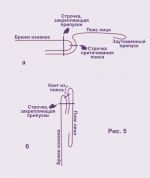 Attention! you need to sew the adjustment belt to the trousers on the wrong side: You should see the wrong side of the trousers and the belt.
Attention! you need to sew the adjustment belt to the trousers on the wrong side: You should see the wrong side of the trousers and the belt.
The allowance is cut, as in turning (Fig. 2a). But further, the dissected allowances are bent towards the trousers and the line securing them is laid along the trousers from the inside (Fig. 5a).
Further, as in the case of turning, the belt must be swept out, forming an edging out of it (Fig. 5b).
The notch is made with two lines of oblique stitches (Fig. 6). The first (top) line is on the wrong side to see the piping from the belt, the second (bottom) line is on the face to see the ironed edge of the belt.
We finish with ironing, laying finishing lines, removing notches and steaming.
Processing the waist section with piping
The easiest way. Suitable for any waist cuts.
See article How to make bias tape at home...
Processing the waist section with a lining
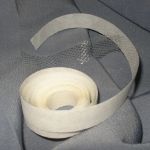 Suitable only for skirts made of thin fabrics. The lining is cut out according to the pattern of the skirt, but instead of tucks, tucks are made on it.
Suitable only for skirts made of thin fabrics. The lining is cut out according to the pattern of the skirt, but instead of tucks, tucks are made on it.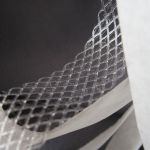
Processing is actually the same as turning, only instead of the latter there is a lining.
Note for newbies. The lining should not be thicker or stiffer than the fabric of the skirt.

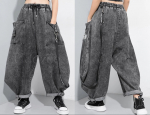


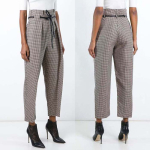
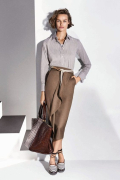
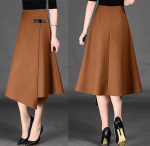
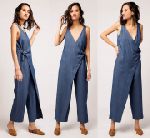


 Join my community on Viber...
Join my community on Viber...











